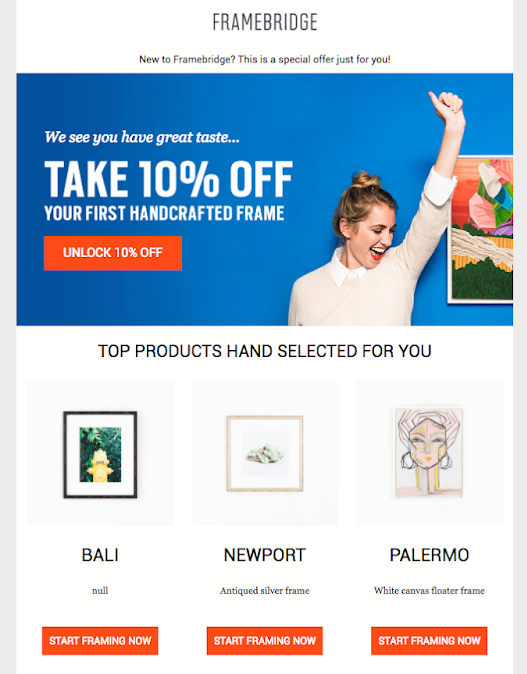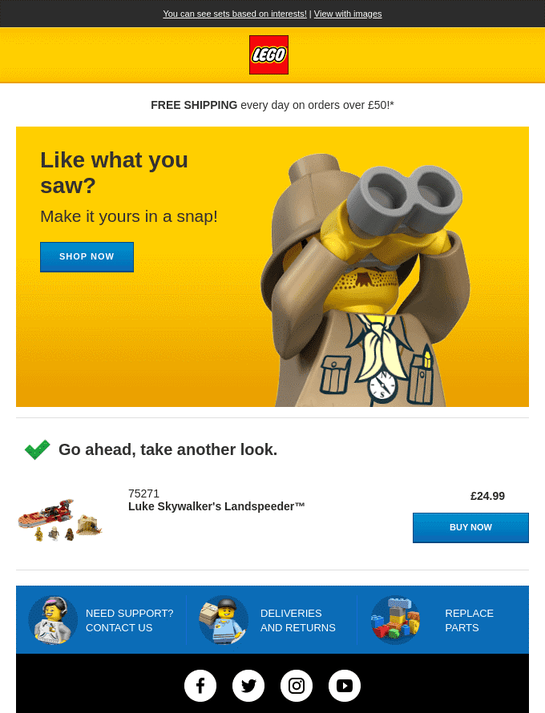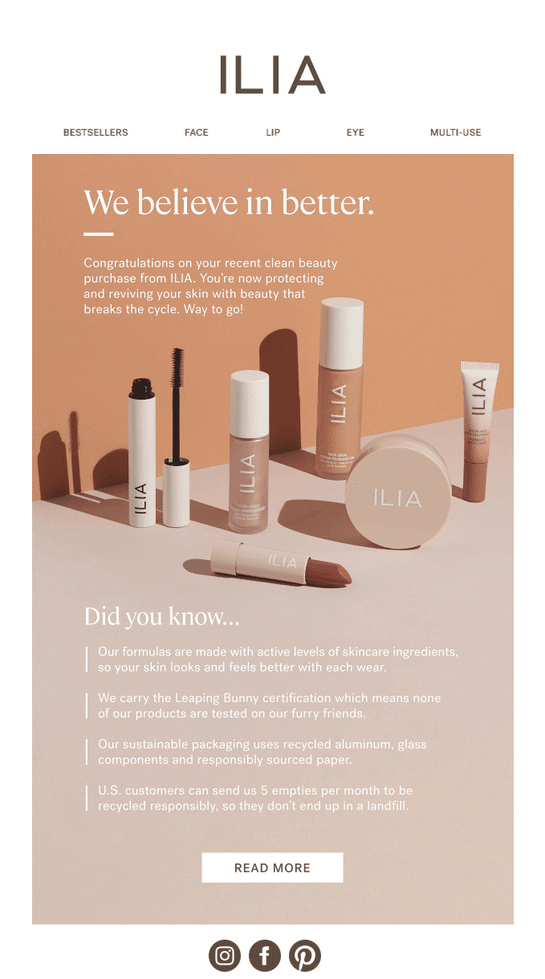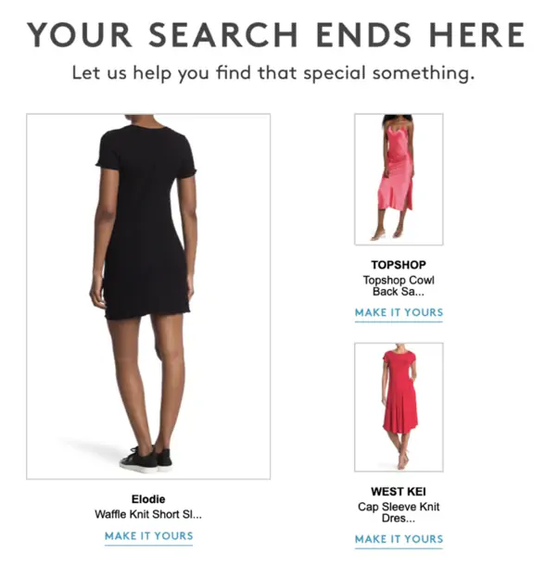AdRoll vs. MNTN
How do AdRoll and MNTN compare when it comes to features, pricing, pros, cons, and use cases? We’ve got the answers.
Read More
Ever think to yourself, “If only I could find a way to encourage website visitors to follow through with their purchases even after leaving my site?” Two words: email retargeting.
The merits of email retargeting speak for themselves — while only 2% of shoppers convert during their first visit to your site, nearly 60% of shoppers say that marketing emails affect their purchase decision-making process. Meanwhile, a study found that retargeting can boost conversion rates by a massive 150%.
Case in point: Window shoppers and cart abandoners are no longer a lost cause. Here’s everything you need to know about email retargeting.
In this article:
What Is Email Retargeting?
When Should You Use Email Retargeting?
How Do I Start Email Retargeting?
Time to Double Your Conversion Rate With Retargeting Emails and Ads
Retargeting is a common ecommerce marketing tactic used to reach shoppers who don’t follow through on your CTA — whether it’s adding items to their cart, checking out, or following you on social media. Retargeting can span multiple channels, including display ads, CTAs, or in this case, email campaigns.
Like ads retargeting, email retargeting is triggered by visitors' behavior on your website, often tracked by browser cookies. However, unlike ads retargeting, which enables you to retarget anonymous visitors after leaving your website, email retargeting can only reach visitors in your email subscriber lists. While email retargeting may have a smaller reach, it gives marketers the ability to create a highly personalized experience. In fact, email retargeting and ads retargeting are complementary to each other. On average, marketers using both retargeting methods have a 2x conversion rate and faster conversion time.
Whichever option you choose, successful email retargeting is all about crafting the right message and directing it to the right people. It only works when you use the information you know about shoppers to create highly targeted marketing relevant to their shopping behaviors — what they’ve purchased previously, what they want, and what they need.
Email retargeting works best for brands that:
Many shoppers who visit your website will click on product categories, read some reviews, maybe even skim through your FAQ page… and exit without ever adding anything to their carts. What to do about these shoppers who give up halfway through your sales funnel?
With email retargeting, reengaging with these inactive visitors becomes easy. Framebridge, for example, will send out a simple retargeting email that includes a list of “top products hand-selected for you” based on what site visitors clicked on and browsed through. To give shoppers an extra boost, they even include a 10% off coupon.
Example of Framebridge retargeting email. Source: Really Good Emails
A huge way for ecommerce brands to leverage email retargeting is by recovering abandoned carts — according to Statista, a whopping three out of four customers will abandon their shopping carts halfway through their checkout journey. (That’s $4 trillion in lost revenue each year!)
When it comes to recovering these lost sales, email retargeting is an opportunity for you to:
This retargeting email from Lego not only reminds shoppers of what they left in their cart but also includes messaging that alludes to how easy it is to check out. Source: Really Good Emails
One of the biggest advantages of email retargeting is how easy it is to segment your audiences. That’s why you should consider cross-selling or upselling customers who have just completed a purchase, in case they hadn’t fully explored your product catalog during their shopping journey.
You can:
This retargeting email from beauty brand ILIA goes beyond thanking the shopper for their recent purchase. It also includes a list of value propositions and a CTA to learn more. Source: Really Good Emails
Ready to get started on your journey toward lower bounce rates, more conversions, and higher revenue numbers?
As with any type of digital marketing, there are a couple of best practices that you’ll need to keep in mind when designing your email retargeting campaign. Luckily, an email retargeting solution makes it easy for you to work smarter.
It may seem obvious, but you can’t build a successful email retargeting campaign without a robust email subscriber list. To get started on this database, you can:
Of course, you’ll want to be transparent about how you’ll use this first-party information — adding a disclaimer promising that you won’t spam people’s inboxes won’t hurt.
Payton Jewelry, a popular accessories brand, offers 15% off your first purchase when signing up for their emails.
Pro tip: While you’re collecting email addresses, consider asking for phone numbers as well, in case you want to dabble in SMS marketing in the future.
Next up is the vital step of defining your audience segments. In other words, dividing up your email list into more specific and detailed subsets, ensuring you aren’t sending irrelevant emails to, say, shoppers who are waiting for their orders to arrive. After all, you never want shoppers to receive an email and think, “Why did you send this to me?”
Depending on your goals, you can segment your audience based on different characteristics. When you use email retargeting, you can define audience segments in virtually any way you like, including by:
A study conducted by BI Intelligence found that emails sent within three hours after a shopper abandons their cart see a 40% open rate and 20% click-through rate. Other experts recommend retargeting emails within an hour of a customer abandoning your site. (Ultimately, the magic number will depend on why people choose to exit and what type of retargeting email you’re sending.)
But shooting emails out quickly isn’t the complete answer — in fact, the last thing you want is to spam and annoy shoppers. Instead, you’ll need to plan your email sequences methodically, starting with a kind reminder, followed by a small incentive, and ending with copy that evokes urgency and FOMO.
Great emails have captivating subject lines, compelling content, and strong CTAs that encourage you to take action. Unsurprisingly, they’re not easy to create. Here are some ideas and tips for you top-notch email marketers out there:
Oh, how we love to see emails that load quickly, are visually attractive, and tell you precisely what you need to do next.
The usual rules for visual marketing materials apply to retargeting emails too:
Your email subject line is the first (and oftentimes only) thing shoppers see. To ensure people don’t immediately click the “delete email” button, you can:
Though there’s a lot of value to a promotional or cart abandonment retargeting email, we also love a good piece of content that lands in our inboxes. Here you can:
Content that provides actionable value goes a long way in encouraging shoppers to click on your CTA to learn more.
When you’re reminding shoppers of your products’ value proposition, don’t forget to harness the power of social proof — 85% of consumers trust online reviews as much as personal recommendations. Whether it’s featuring testimonials for popular products or displaying the number of reviews of top-of-mind products, it’s hard to go wrong with these trust markers.
To keep your retargeting emails as relevant as possible, we highly recommend personalization. By pinpointing exactly what shoppers may be looking for, personalized retargeting emails can save them an immense amount of time and effort (which is particularly valuable if you have an extensive product catalog, like Nordstrom!)
Nordstrom delivers personalized product recommendations straight to your inbox.
Beyond that, our personalization attributes include everything from geographical location to product recommendations with specific price ranges.
How do you know if your subject lines, visuals, offers, or content needs work? That’s where A/B testing comes in.
For Klaviyo customers, we can import Klaviyo lists and segments for coordinated ad targeting on display, Facebook, Instagram, TikTok, and Pinterest. By importing metrics, we help customers analyze email performance alongside their AdRoll ads campaigns. Our CCA dashboard can help you attribute across all of your marketing channels — ads, email, SMS, social, search, and more.
Last updated on January 30th, 2025.




